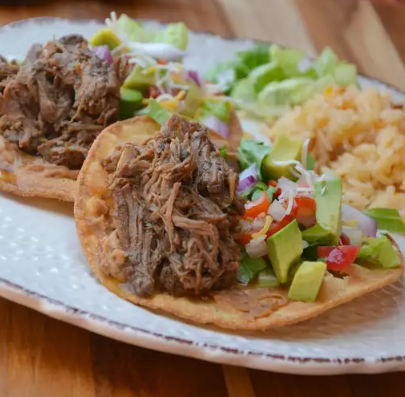Introduction to Barbacoa Seasoning
What is barbacoa seasoning made of? Barbacoa seasoning, a blend of aromatic spices like dried chilies, garlic, and cumin, is central to the flavors of Mexican barbacoa. This seasoning transforms simple meats into rich, flavorful dishes.
What is Barbacoa Seasoning?
Traditionally used in slow-cooked meats, barbacoa seasoning adds depth with its combination of robust and intricate spices. It’s commonly used for beef, lamb, or goat cooked over open fires or in modern slow cookers.
Historical Background and Usage
Originating from Caribbean techniques adopted by Mexican cuisine, barbacoa involves cooking meat wrapped in maguey leaves, slow-roasted to achieve a smoky flavor and tender texture. The spices have evolved to not only enhance flavor but also tenderize the meat, making barbacoa seasoning a staple for various dishes beyond traditional uses.
Key Ingredients of Barbacoa Seasoning
Barbacoa seasoning blends several spices to create its distinct flavor, essential in Mexican cooking.
Common Spices Used
Key spices include:
- Cumin: Adds earthiness.
- Dried Chile Peppers: Provide heat and smokiness.
- Garlic Powder: Enhances with a sharp, pungent flavor.
- Oregano: Offers herbal notes, often using the Mexican variety for more intensity.
- Black Pepper and Salt: Essential for overall flavor enhancement.
Role of Each Spice in the Flavor Profile
- Cumin and dried chile peppers form the base, giving depth and smokiness.
- Garlic powder and oregano balance and complement the heat with sharp and herbal flavors.
- Salt and pepper round out and intensify all other flavors.
Unique Additions and Variations
Regional tweaks might include:
- Cloves and Cinnamon: Add a hint of sweetness and aroma.
- Bay Leaves: Contribute a floral and woodsy scent during cooking.
- Lime Zest: Modern recipes sometimes include this for a citrusy lift.
These ingredients and their variations showcase the adaptability and regional diversity of barbacoa seasoning.
Making Homemade Barbacoa Seasoning
Creating your own barbacoa seasoning at home allows for customization and ensures freshness. Here’s how you can prepare a traditional barbacoa spice mix with ease.
Step-by-Step Recipe
- Gather Ingredients: You will need 2 tablespoons each of ground cumin, dried oregano (preferably Mexican), and garlic powder; 1 tablespoon of ground black pepper; 3 tablespoons of ground dried chile (ancho or chipotle are recommended); and salt to taste.
- Mix Spices: In a bowl, combine all the spices thoroughly. For a more authentic flavor, you can lightly toast the cumin and dried chile powders in a dry skillet over low heat until they become fragrant, about 1-2 minutes, before mixing with the other spices.
- Adjust to Taste: Taste your spice mix and adjust the seasoning as needed. Depending on your preference, you might add more chili for heat, garlic powder for pungency, or salt for overall flavor enhancement.
- Store Properly: Transfer the seasoning mix to an airtight container to keep it fresh.
Tips for the Best Seasoning Mix
- Freshness of Spices: Always use fresh, high-quality spices for the best flavor. Spices lose their potency over time, so older spices may not deliver the robust flavors you’re looking for.
- Grinding Spices: For an even fresher taste, consider grinding whole spices yourself. This is particularly effective for cumin seeds and dried chiles.
- Heat Levels: Customize the heat level by choosing different types of chile powders or adjusting the quantity used according to your heat tolerance.
Storage and Shelf Life
- Airtight Container: Store the barbacoa seasoning in an airtight container to prevent moisture and air from diluting the flavors.
- Cool, Dark Place: Keep the container in a cool, dark place like a pantry or cupboard, away from direct sunlight and heat sources, which can degrade the spices quickly.
- Shelf Life: When stored properly, homemade barbacoa seasoning can last up to 6 months without losing its potency.
Culinary Uses of Barbacoa Seasoning
Barbacoa seasoning is versatile, enhancing a wide range of dishes with its rich, smoky flavor. Here’s how to incorporate it into both traditional and creative culinary applications.
Traditional Uses in Dishes
Barbacoa seasoning is traditionally used to flavor meats for barbacoa, a cooking method where meat is slow-cooked over an open fire or in a pit. It’s most commonly applied to:
- Beef: Especially beef cheeks or brisket, which are marinated with the seasoning and then slow-cooked until tender.
- Lamb and Goat: These meats are also popular choices, particularly in regions of Mexico where they are preferred for their distinct flavors.
Besides meats, barbacoa seasoning is used in:
- Stews and Soups: A sprinkle of barbacoa seasoning can add depth to beef stews and soups, enriching the broth with complex flavors.
Creative Ways to Use Barbacoa Seasoning
Barbacoa seasoning can be used beyond traditional dishes to add a unique twist to everyday cooking:
- Vegetarian Dishes: Sprinkle it over roasted vegetables or mix into vegetarian chili to bring a smoky spice without the meat.
- Marinades: Use it in marinades for grilling chicken, pork, or even seafood.
- Snacks: Enhance popcorn, nuts, or potato chips with a light dusting of barbacoa seasoning for a smoky, spicy snack.
Pairing with Meats and Vegetables
The robust flavor of barbacoa seasoning pairs well with various meats and vegetables, making it a flexible choice for many recipes:
- Meats: Beyond the traditional choices, try it with pork ribs, turkey, or even fish like salmon to add an unexpected flavor profile.
- Vegetables: Hearty vegetables like potatoes, carrots, and sweet potatoes are excellent when seasoned with barbacoa spice. It also pairs well with greens like kale and chard, providing a nice contrast to their earthy flavors.
Health Benefits and Dietary Considerations
Barbacoa seasoning not only enhances the flavor of dishes but also brings certain health benefits, making it a valuable addition to a balanced diet. Here’s a look at its nutritional aspects and how it fits into various dietary needs.
Nutritional Profile of Barbacoa Seasoning
Barbacoa seasoning is typically low in calories but rich in minerals and vitamins due to its spice components. Key nutritional aspects include:
- Antioxidants: Many spices, like chile peppers and garlic powder, contain antioxidants that help reduce oxidative stress.
- Anti-inflammatory properties: Ingredients like cumin and garlic have anti-inflammatory properties that can contribute to better overall health.
- Metabolism boost: Spices, especially those with capsaicin like chile peppers, are known to boost metabolism, aiding in weight management.
These spices also provide small amounts of micronutrients such as iron, manganese, and magnesium, which are essential for various bodily functions.
Gluten-Free and Allergy-Friendly Options
Barbacoa seasoning is naturally gluten-free, making it suitable for those with celiac disease or gluten sensitivity. To ensure it stays gluten-free, be mindful of cross-contamination if you’re purchasing pre-made mixes or make it at home using spices that are certified gluten-free.
For those with allergies, homemade barbacoa seasoning can be easily adjusted to avoid common allergens:
- No nuts or dairy: Unlike some commercial spice mixes, homemade barbacoa seasoning does not require any nut or dairy additives, making it safe for those with nut allergies or lactose intolerance.
- Adjustable components: If allergic to certain spices, you can modify the recipe to exclude them or find suitable substitutes that don’t trigger allergies.
Comparing Barbacoa Seasoning with Other Traditional Mexican Spices
Barbacoa seasoning, while distinct, shares the stage with other iconic Mexican spices. Understanding its differences from taco seasoning, adobo, and mole provides insight into the rich tapestry of Mexican culinary arts.
Differences Between Barbacoa and Taco Seasoning
Barbacoa seasoning and taco seasoning share some common ingredients like cumin and chili powder, but they serve different culinary functions:
- Flavor Profile: Barbacoa seasoning tends to be smokier and more robust, typically including spices like dried chile peppers and cloves, which are less common in taco seasoning.
- Usage: While both are used in meat dishes, barbacoa seasoning is specifically designed for slow-cooking processes, enhancing the meat’s flavor through prolonged exposure to heat and smoke. Taco seasoning, on the other hand, is suited for quicker cooking methods.
How Barbacoa Seasoning Stands Out from Adobo and Mole
Barbacoa seasoning also differs significantly from adobo and mole, each of which has a unique place in Mexican cuisine:
- Adobo: Adobo seasoning often includes a blend of spices mixed with vinegar, giving it a tangy flavor that is quite distinct from the dry and smoky nature of barbacoa seasoning.
- Mole: Mole is a complex sauce that combines chocolate, spices, and often fruits, which contrasts sharply with the straightforward spice blend of barbacoa. While mole provides depth and richness to dishes, barbacoa seasoning offers a direct, spice-driven heat.
Barbacoa seasoning’s unique characteristics make it a standout choice for specific dishes, emphasizing its role in creating authentic Mexican flavors that are both nuanced and bold.
Expert Tips for Mastering Barbacoa Cooking Techniques
Perfecting barbacoa requires understanding both the ingredients and the cooking methods involved. Here, chefs share their top tips for making authentic barbacoa and highlight common mistakes to avoid.
Tips from Chefs for Perfect Barbacoa
Experts in Mexican cuisine recommend several key practices to achieve the perfect barbacoa:
- Meat Selection: Choose the right type of meat. Beef cheek and lamb are traditional and preferred for their fat content and tenderness after long cooking.
- Marinating: Marinate the meat for at least several hours, if not overnight. Use a mix of barbacoa seasoning, citrus juices, and aromatics to enhance the meat’s flavor and tenderness.
- Low and Slow Cooking: Cook the meat at a low temperature for several hours. This can be done in a slow cooker, in a pit, or in an oven wrapped in banana leaves or foil to retain moisture.
Common Mistakes to Avoid in Barbacoa Preparation
Even seasoned cooks can make mistakes when preparing barbacoa. Here are some to watch out for:
- Overlooking the Cut of Meat: Using lean cuts like breast or tenderloin can result in dry and tough barbacoa. Fattier cuts are better suited for the slow cooking process.
- Rushing the Cooking Process: Trying to speed up the cooking by increasing the temperature can lead to unevenly cooked meat that lacks the traditional barbacoa’s tenderness.
- Skimping on Seasoning: It’s essential to use enough seasoning to cover all the meat. Underseasoning can result in bland flavors that don’t do justice to the barbacoa tradition.
Frequently Asked Questions
Barbacoa seasoning is versatile and can be adapted to various dietary preferences and needs. Here are some common questions and answers to help you customize your seasoning mix.
Can Barbacoa Seasoning be Made Without Salt?
Yes, barbacoa seasoning can be made without salt. To maintain flavor, increase the amounts of other spices like cumin, garlic powder, and chile peppers. You can also add salt substitutes like potassium chloride or enhance flavors with citrus zest or vinegar powders for a punch without the sodium.
How to Make a Low-Spice Version?
To make a low-spice version of barbacoa seasoning, reduce or omit the chile pepper content and focus on aromatic and less spicy ingredients like cumin, oregano, and black pepper. You can also add mild paprika for color and a subtle sweetness without adding heat.
Are There Any Vegan Alternatives?
Barbacoa seasoning itself is inherently vegan, as it consists only of plant-based spices. However, for dishes typically using this seasoning, you can apply it to vegan protein sources like tempeh, tofu, or textured vegetable protein (TVP) to mimic the textures and flavors of traditional meat-based barbacoa.
Recommended Internal Links
-
- Internal Link for « Barbacoa-Style Shredded Beef »
-
-
- Keyword/Phrase: « traditional barbacoa »
- URL: Barbacoa-Style Shredded Beef
- Context: In the section discussing traditional uses of barbacoa seasoning in dishes, link to this post to provide readers with a specific recipe example that utilizes barbacoa seasoning.
- Internal Link for « What Cut of Beef is Used for Barbacoa »
- Keyword/Phrase: « right type of meat »
- URL: What Cut of Beef is Used for Barbacoa
- Context: When you mention choosing the « right type of meat » in your tips for perfect barbacoa, embed this link to guide readers to a post that explains which cuts are best for barbacoa, enhancing their understanding and practical knowledge.
-
Additional Resources and Readings
- Texas Monthly Article on Barbacoa’s History
- Title: « A Head Above: How Barbacoa Paved the Way for Barbecue »
- URL: How Barbacoa Paved the Way for Barbecue – Texas Monthly
- Keyword/Phrase to Embed the Link: « historical background »
- Context: In the section discussing the historical background and usage of barbacoa, link to this detailed article to provide readers with an in-depth look at how barbacoa influenced modern barbecue techniques and its cultural significance.
- Delish Article on Barbacoa
- Title: « What is Barbacoa? – A History and Explanation Of Mexican Barbacoa »
- URL: Mexican Barbacoa Guide – Delish
- Keyword/Phrase to Embed the Link: « What is Barbacoa Seasoning? »
- Context: When introducing what barbacoa seasoning is, link to this article to provide readers with additional context on the origins of barbacoa in Mexican cuisine and its different styles across regions.
- Wikipedia on Barbacoa
- Title: « Barbacoa »
- URL: Barbacoa – Wikipedia
- Keyword/Phrase to Embed the Link: « Barbacoa isn’t just the name for shredded beef »
- Context: In the subsection explaining the broader definition of barbacoa, insert this link to offer readers comprehensive information about the various methods and traditions of barbacoa across different cultures and regions.
Conclusion and Final Thoughts
Barbacoa seasoning is more than just a spice mix; it’s a cultural emblem that carries centuries of culinary tradition. Its complex flavors and versatile applications have made it a staple in not only Mexican cuisine but also in kitchens around the world.
Summary of Barbacoa Seasoning’s Impact on Culinary Practices
What is barbacoa seasoning made of?The exploration of barbacoa seasoning in this article reveals its significant impact on culinary practices. It enhances flavors, transforms simple dishes into gourmet experiences, and adapts to various cooking methods. Its rich history and adaptability have cemented its place in culinary traditions, showcasing how a simple blend of spices can profoundly influence cooking practices and flavor perceptions.
Encouragement to Experiment with Homemade Mixes
I encourage you to try creating your own barbacoa seasoning at home. Experimenting with homemade mixes not only allows you to tailor flavors to your preferences but also connects you with the artisanal aspects of cooking. Adjusting the spice levels, experimenting with additional ingredients, and applying the seasoning to non-traditional dishes are all ways to make this spice mix uniquely yours.



